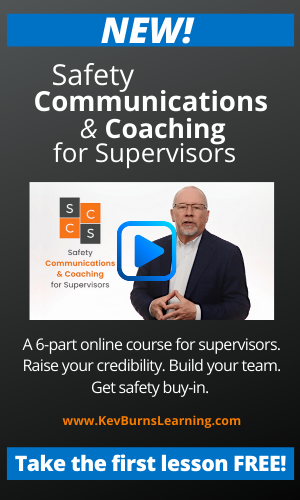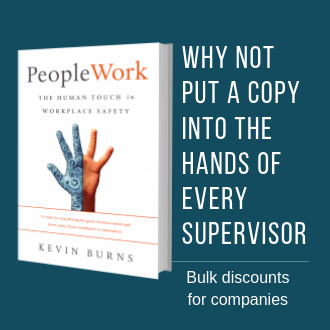3 Tips for Motivating in Safety
One of the questions I’m asked most often is “How do we motivate employees to be enthusiastic about safety?”
As discussed in Chapter 6 of the course Safety Communications & Coaching for Supervisors, the first thing to consider when you are trying to help improve motivation for safety is that employees rarely get excited or motivated about anything that isn’t completely clear of what is in it for them.

You are going to have a hard time getting buy-in on something that they feel was pushed down onto them. Anything that seems punitive, rules-based or force-fed, and you are not going to get their buy-in or their motivation. Think about how you react when you’re forced to do something that was decided for you.
3 parts to selling safety and motivating people: Brand, Benefits and Wins.
If you want your people to buy-in to safety, you’re going to have to approach it with the intent of asking your people to help you to create a better culture of safety. You are going to need to consult with and involve your people in a way that makes them feel part of the team and part of the decisions that are being made. And, most of all, before you do any of that, you are going to have to make some decisions in three different areas about what kind of safety program you are building.
Let’s talk about the three key parts that will help with selling your safety program effectively:
Brand
First, decide what your particular brand of safety is. Is it to just meet the bare minimum? To let your people bring all of their bad habits learned at former workplaces. Or is your brand of safety one that encourages participation and ownership? Where your people all have a stake in looking out for each other.
Are you a premium product of safety; one that exceeds minimums and helps yours to become a world-class organization?
Is yours a budget brand of safety, that only checks the boxes and meets the minimums but not much else? Or are you a premium product of safety; one that exceeds minimums and helps yours to become a world-class organization?
If you want to encourage better participation and motivation for the safety program, you have to decide what brand of safety you’re selling. And then make sure that everything you do lines up to support that brand. So, first, decide what your particular brand of safety is.
Benefits
Second, focus on benefits. Stop spending so much of your time on rules and start spending a lot more time on the benefits of safety. What are the benefits? Well, safety training prepares your people to be able to deal with uncertainty. It trains them to react well. It builds their personal confidence to make good choices because they know exactly what to do.
Safe people are just more dependable. And, dependable people get more opportunities. Put another way, people who don't follow safety don't get put in charge. They don’t get picked for much. But good safety performers get noticed and get the ear of management. They have better influence. Just a few examples of what the benefits of safety might look like.
A benefit is a clear positive, not avoiding a negative.
Now, as much as we discuss what is considered a benefit in safety, it is equally important to understand what a benefit is not. Let me tell what a benefit is not. Saying things like “you don’t get hurt” is NOT a benefit. You see, they’re not hurt now so they would have to do nothing different to get the exact same result. Don’t try to guilt your people or scare them into following rules. It makes you look amateurish.

Stay away from the things that you “won’t” get in safety, like won’t get hurt, won’t get fired, won’t get in trouble. A benefit is a clear positive, not avoiding a negative. As a supervisor, you have to understand the clear distinction between the two if you want to help your team find its motivation for safety and for looking out for each other. So, the second part is being clear about identifying their benefits.
Wins
And finally, the third part of what will help you sell the safety brand is wins. Find ways to get your people more wins. So, what makes it a win? And don’t say “going home safe” because going home safe is not a win. Going home safe is what they’re supposed to do. That’s the law. Meeting the bare minimum is not a win – it’s the least you’re allowed to do by law. Besides, most of your people are already going home safe now. They don't have to do anything different to get the same result. But to get a win, you want them to do something different.
Going home safe is not a win. Going home safe is what they’re supposed to do.
Like the baseball manager, your job is to help your people get more wins, more reasons to celebrate doing something well. Nothing motivates like success. So, the more success opportunities you put in front of them, the more they are likely to achieve many small wins. It’s in adding up all of the little wins that keeps your people on track and willing to continue to perform. Give your people more wins. That’s the third part.
Companies that focus on helping their people improve attract employees who want to get better. Better workplaces attract better employees.
If you’re going to make yourself more effective at selling your safety program, and you want to build excitement and motivation in getting your people on-board with the safety program, you need to consider all three parts: Brand, Benefits and Wins.
-- Take the FREE preview lesson of Kevin's course Safety Communications & Coaching for Supervisors. 40-minutes of video instruction, summary download PDFs and a companion audio MP3 version to take with you on the go. SCCS is an online course to help energize safety, build teamwork, and get employee buy-in.
Take the FREE preview lesson of Kevin's course Safety Communications & Coaching for Supervisors. 40-minutes of video instruction, summary download PDFs and a companion audio MP3 version to take with you on the go. SCCS is an online course to help energize safety, build teamwork, and get employee buy-in.
Kevin Burns, consultant/author, works with smart, caring companies to energize safety culture, build teamwork, and get employee buy-in. KevBurns Learning is committed to to helping companies improve safety by improving people, through creative learning materials, virtual strategy sessions, safety meeting presentations, and team coaching programs.
In 2020, BookAuthority.org named PeopleWork #7 of The Top 44 Workplace Safety Books of All Time. Buy yourself a copy of PeopleWork: The Human Touch in Workplace Safety and give another as a gift to a colleague.
Subscribe to Kevin's YouTube channel.
Subscribe to Kevin’s Blog.


